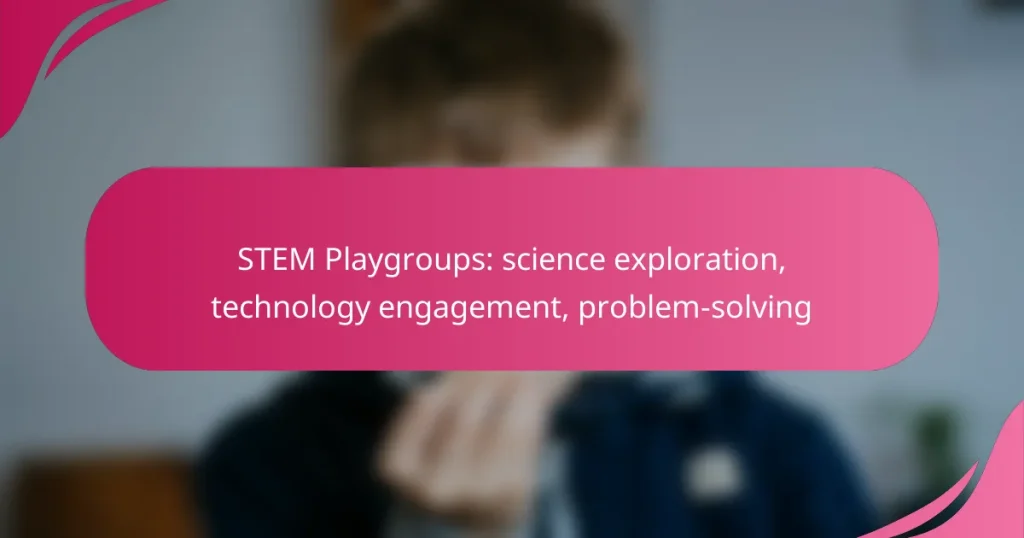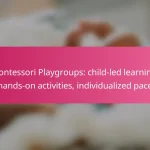STEM playgroups offer children a dynamic environment for science exploration, technology engagement, and problem-solving. By incorporating hands-on activities, these playgroups foster curiosity and critical thinking, allowing children to experiment and discover scientific concepts in an enjoyable manner. Through collaborative experiences, kids enhance their problem-solving skills while exploring technology in innovative ways.
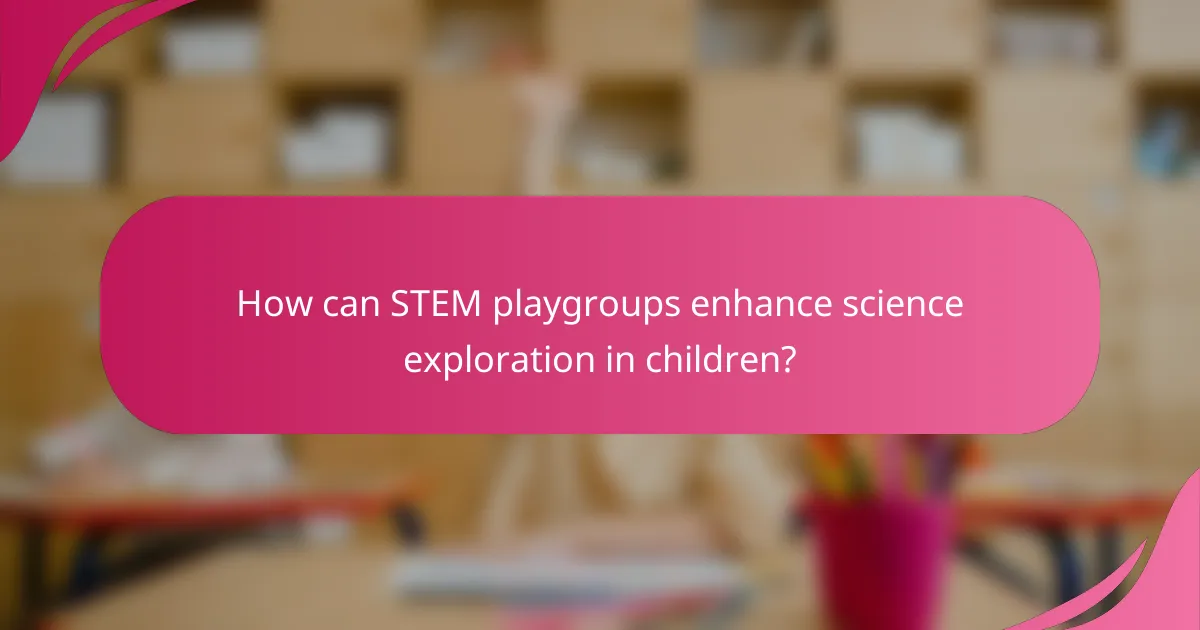
How can STEM playgroups enhance science exploration in children?
STEM playgroups significantly enhance children’s science exploration by providing engaging, hands-on experiences that stimulate curiosity and critical thinking. These environments encourage children to ask questions, experiment, and discover scientific concepts in a fun and interactive way.
Hands-on experiments
Hands-on experiments are a cornerstone of STEM playgroups, allowing children to directly engage with scientific principles. Activities like simple chemical reactions using household items or building structures with blocks help children understand concepts like cause and effect.
To maximize learning, choose experiments that are age-appropriate and safe. For example, younger children can explore mixing baking soda and vinegar, while older kids might enjoy creating circuits with batteries and light bulbs. Always supervise to ensure safety and encourage exploration.
Interactive science kits
Interactive science kits provide structured yet flexible opportunities for children to explore various scientific fields. These kits often include materials and instructions for experiments in areas like biology, physics, or chemistry, making them suitable for diverse interests.
When selecting science kits, consider the child’s age and interests. Kits that allow for open-ended exploration, such as those that involve building or creating, can foster creativity alongside scientific understanding. Look for kits that align with local educational standards to ensure relevance.
Outdoor science activities
Outdoor science activities offer a dynamic way for children to explore the natural world. Activities like nature scavenger hunts or weather observations can teach children about ecosystems, weather patterns, and environmental science.
Encourage outdoor exploration by providing tools like magnifying glasses or simple field guides. Local parks or gardens can serve as excellent venues for these activities, allowing children to connect with their environment while learning about science in a real-world context.
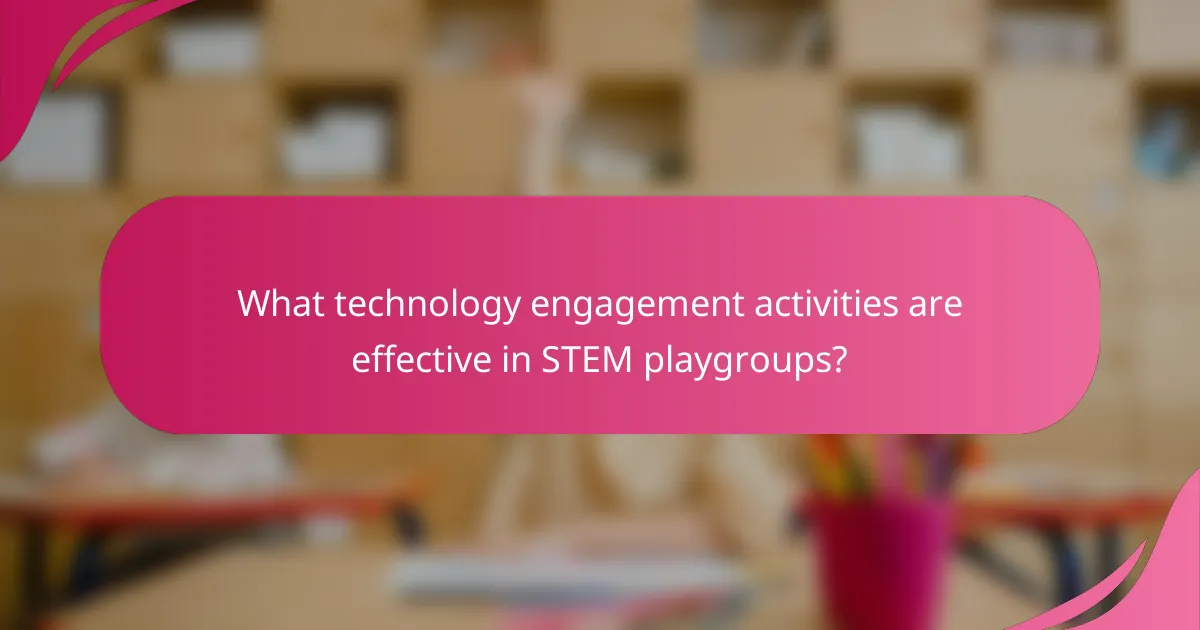
What technology engagement activities are effective in STEM playgroups?
Effective technology engagement activities in STEM playgroups include hands-on experiences that stimulate curiosity and problem-solving. Activities like robotics workshops, programming games, and virtual reality experiences help children explore technology in a fun and interactive way.
Robotics workshops
Robotics workshops provide children with the opportunity to build and program robots, fostering teamwork and critical thinking. Participants typically work in small groups, allowing them to collaborate on tasks such as assembling robot kits and writing simple code to control their creations.
When planning a robotics workshop, consider using age-appropriate kits that cater to different skill levels. Popular options include LEGO Mindstorms and VEX Robotics, which offer a range of complexity suitable for young learners.
Programming games
Programming games engage children by teaching coding concepts through play. These games often use visual programming languages, making it easier for beginners to grasp fundamental concepts without needing to learn complex syntax.
Examples of effective programming games include Scratch and Code.org, which provide interactive challenges that encourage logical thinking and creativity. Incorporating these games into playgroup sessions can enhance children’s understanding of technology while keeping them entertained.
Virtual reality experiences
Virtual reality (VR) experiences immerse children in interactive environments where they can explore scientific concepts and technological applications. VR can transport users to different settings, such as outer space or underwater, making learning engaging and memorable.
To implement VR in playgroups, consider using platforms like Google Expeditions or Oculus Quest, which offer educational content tailored for younger audiences. Ensure that safety guidelines are followed, including age restrictions and supervision, to create a safe and enjoyable learning environment.

How do STEM playgroups foster problem-solving skills?
STEM playgroups enhance problem-solving skills by providing children with hands-on experiences that encourage exploration and collaboration. Through engaging activities, children learn to approach challenges creatively and develop critical thinking abilities.
Collaborative projects
Collaborative projects in STEM playgroups allow children to work together, sharing ideas and strategies to solve problems. For example, building a simple bridge using everyday materials can teach teamwork and communication while fostering engineering skills.
These projects often involve roles, where each child contributes their strengths, promoting a sense of responsibility and accountability. This collaborative environment helps children learn to negotiate and compromise, essential skills for effective problem-solving.
Critical thinking challenges
Critical thinking challenges present children with puzzles or scenarios that require logical reasoning and innovative solutions. Activities like coding a simple robot to navigate a maze encourage kids to think critically about the steps needed to achieve their goals.
These challenges can be structured with varying difficulty levels, allowing children to progress at their own pace. Providing feedback and discussing different approaches after completing a challenge reinforces learning and encourages deeper understanding.
Real-world problem scenarios
Real-world problem scenarios help children connect STEM concepts to everyday life, making learning relevant and engaging. For instance, discussing how to reduce waste in their community can inspire projects focused on sustainability and environmental science.
By tackling these scenarios, children learn to identify problems, brainstorm solutions, and evaluate the effectiveness of their ideas. This practical application of knowledge not only enhances problem-solving skills but also fosters a sense of civic responsibility.
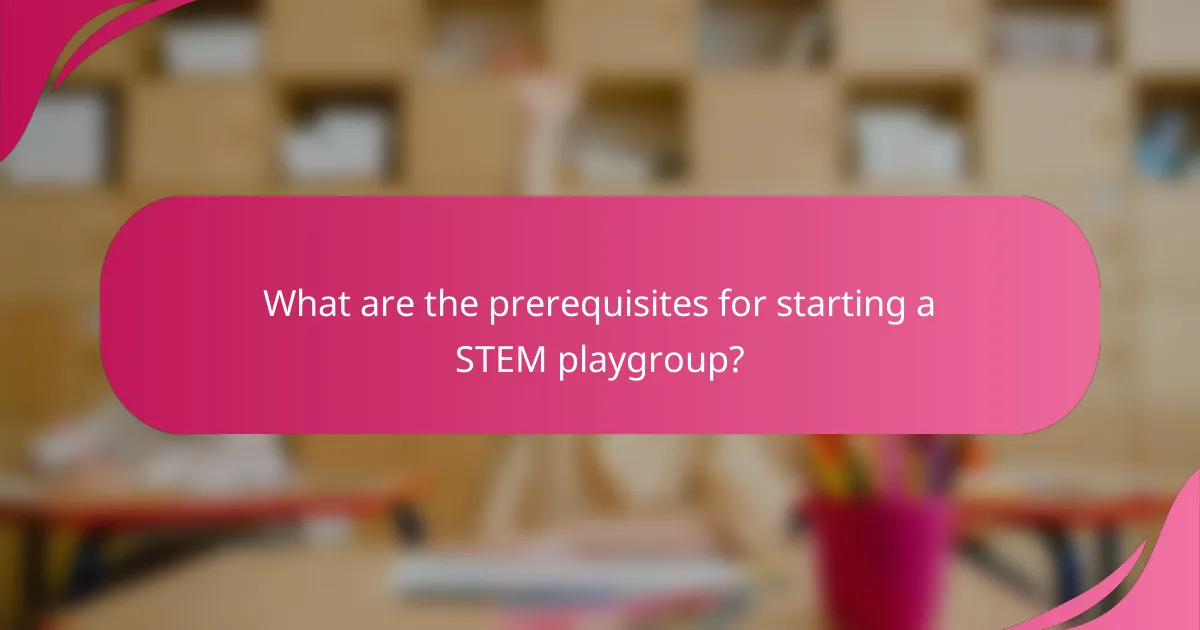
What are the prerequisites for starting a STEM playgroup?
Starting a STEM playgroup requires careful planning regarding space, materials, and staff training. These elements are crucial for creating an engaging environment that fosters science exploration, technology engagement, and problem-solving skills.
Space requirements
A suitable space for a STEM playgroup should be safe, accessible, and large enough to accommodate various activities. Ideally, it should have areas for hands-on experiments, group discussions, and quiet reflection.
Consider using a room with at least 100 square feet for small groups, allowing for movement and interaction. Ensure that the space is equipped with tables, chairs, and storage for materials.
Material needs
Essential materials for a STEM playgroup include basic supplies like building blocks, science kits, and technology tools such as tablets or computers. Additionally, everyday items like cardboard, tape, and scissors can stimulate creativity and problem-solving.
It’s beneficial to have a diverse range of materials to cater to different interests and age groups. Regularly assess and replenish supplies to keep activities fresh and engaging.
Staff training
Staff involved in a STEM playgroup should have training in both educational techniques and the specific content areas of science, technology, engineering, and mathematics. Familiarity with hands-on learning approaches is essential for effective facilitation.
Consider providing professional development opportunities focused on STEM education methodologies. This can include workshops, online courses, or mentorship programs to enhance staff skills and confidence in leading activities.

What criteria should parents consider when choosing a STEM playgroup?
Parents should evaluate several key criteria when selecting a STEM playgroup, including curriculum quality, instructor qualifications, and child-to-instructor ratio. These factors significantly influence the effectiveness of the program in fostering science exploration, technology engagement, and problem-solving skills in children.
Curriculum quality
The curriculum should be engaging, hands-on, and aligned with developmental milestones. Look for programs that incorporate a mix of science, technology, engineering, and mathematics activities that encourage exploration and creativity. For example, a good STEM playgroup might include projects like building simple machines or conducting basic experiments.
Additionally, check if the curriculum is adaptable to various age groups and learning styles. A well-rounded program will offer activities that cater to both younger children and those who are slightly older, ensuring that every child can participate meaningfully.
Instructor qualifications
Instructors should have relevant educational backgrounds and experience in teaching STEM subjects. Ideally, they should possess degrees in fields like science or engineering and have training in early childhood education. This combination ensures that they can effectively communicate complex concepts in an age-appropriate manner.
Furthermore, consider the instructor’s ability to engage with children. Look for playgroups where instructors demonstrate enthusiasm and creativity in their teaching methods, as this can significantly enhance the learning experience for young participants.
Child-to-instructor ratio
A low child-to-instructor ratio is crucial for personalized attention and effective learning. Aim for a ratio of no more than 5:1, which allows instructors to focus on each child’s needs and provide tailored guidance. This setup fosters a supportive environment where children feel comfortable exploring and asking questions.
When assessing playgroups, inquire about their maximum class size and how many instructors are present. Smaller groups often lead to better engagement and a more enriching experience for children as they navigate STEM activities.
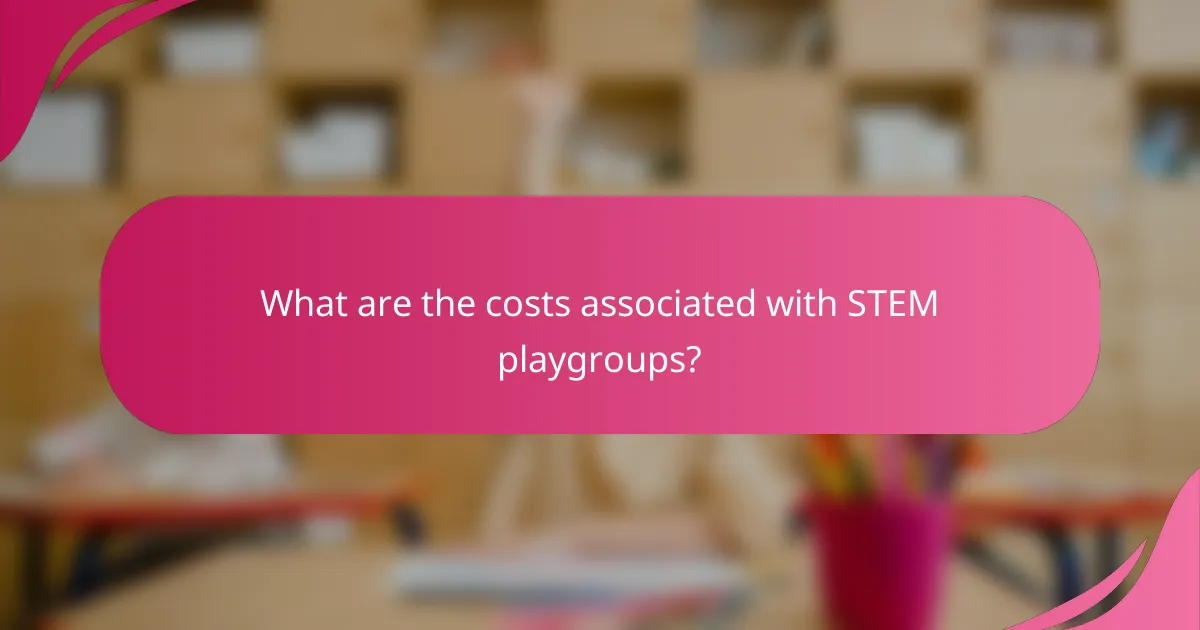
What are the costs associated with STEM playgroups?
The costs associated with STEM playgroups can vary significantly based on location, program offerings, and duration. Generally, families should anticipate expenses related to membership fees and materials needed for activities.
Membership fees
Membership fees for STEM playgroups typically range from low tens to a few hundred dollars per year, depending on the program’s structure and benefits. Some organizations may offer sliding scale fees based on income, while others might provide discounts for siblings or early registration.
When considering membership, evaluate what is included, such as access to workshops, events, and exclusive resources. Some playgroups may charge additional fees for special sessions or field trips, so it’s wise to inquire about all potential costs upfront.
Materials and supplies
Materials and supplies for STEM playgroups can also add to the overall cost. Common expenses include items like building kits, science experiment materials, and technology tools, which can range from a few dollars to several hundred dollars depending on the complexity of the projects.
To manage these costs, consider sourcing materials from local suppliers or community donations. Some playgroups may provide a list of necessary items in advance, allowing families to budget accordingly and avoid unnecessary purchases.
